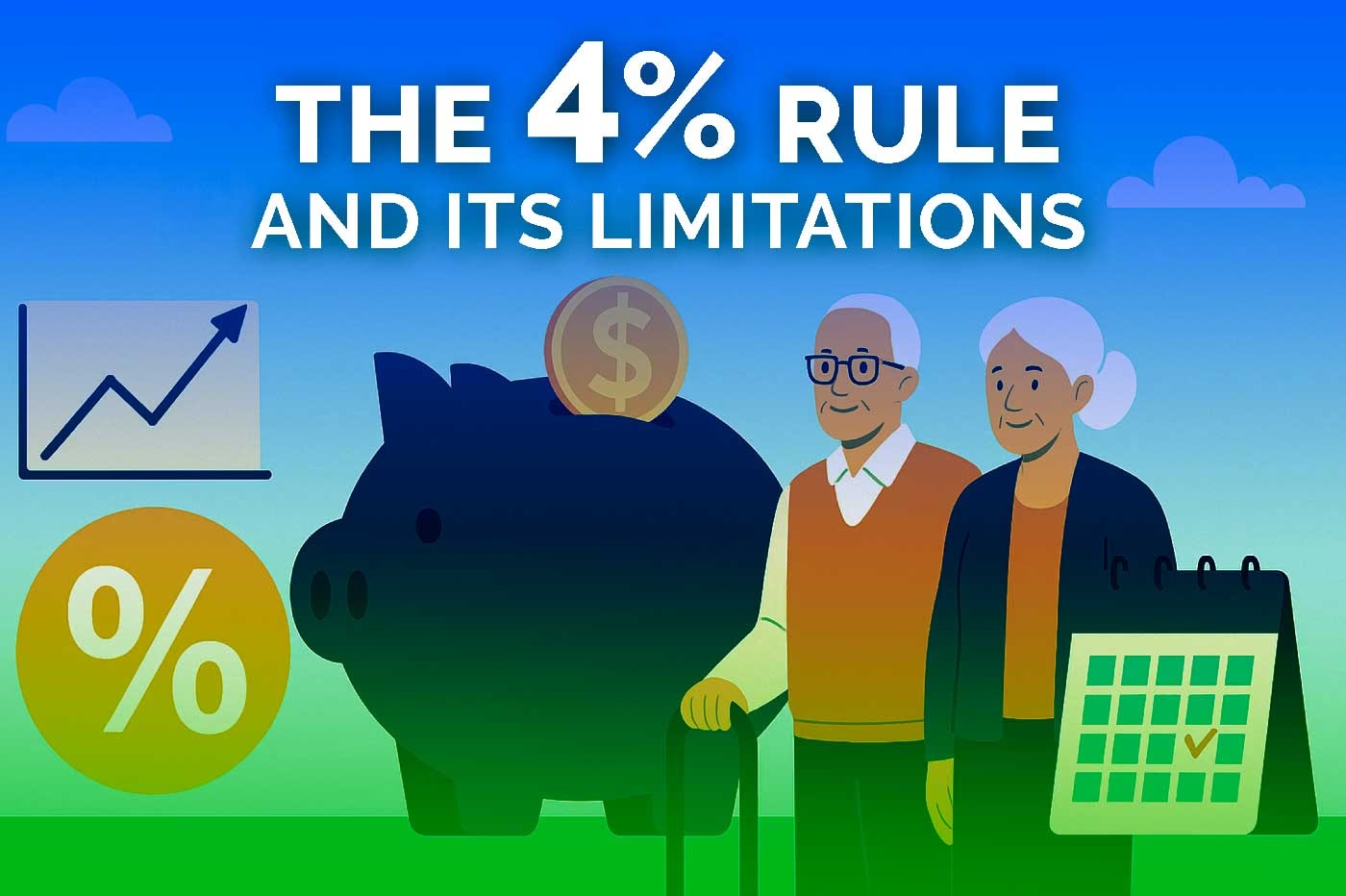When people start planning for retirement, one number tends to come up again and again: 4%.
It’s the “rule of thumb” often cited in articles, calculators, and conversations with financial professionals. But while the 4% Rule offers a helpful starting point, it was built for a different time—and like any rule of thumb, it comes with important caveats.
Let’s break it down: what the 4% Rule is, where it came from, why it matters—and what today’s retirees should consider before relying on it too heavily.
Table of Contents
What Is the 4% Rule?
The 4% Rule is a retirement withdrawal strategy that came from research by financial advisor William Bengen in the 1990s. Later reinforced by the Trinity Study, the rule was designed to answer a crucial question: How much can a retiree safely withdraw each year without running out of money?
Here’s how it works:
-
In your first year of retirement, you withdraw 4% of your total portfolio.
-
Each year after that, you increase the withdrawal by the rate of inflation.
The original study assumed a 30-year retirement with a 50/50 mix of stocks and bonds, using historical U.S. market returns to model success. Under those assumptions, retirees could expect to maintain their income without depleting their nest egg.
Why It Was a Game-Changer
Before this research, retirement income planning felt a bit like flying blind. Bengen’s work gave people a framework—a target they could aim for.
It helped retirees:
-
Feel confident spending in retirement rather than hoarding out of fear.
-
Plan for longevity instead of just hoping their money would last.
-
Think holistically about inflation and asset allocation.
In many ways, the 4% Rule brought clarity and structure to a notoriously fuzzy area of personal finance.
But Retirement Looks Different Today
Here’s the part that’s often left out: Bengen’s 4% Rule was based on market conditions in the late 20th century.
A lot has changed.
1. Today’s Market Is Less Predictable
Bond yields are lower than they were in the 1990s, and stocks face greater volatility. That makes replicating historical returns harder—especially in the early years of retirement.
2. People Are Living Longer
Many retirees today may live well beyond the 30-year timeline the rule assumes. That extra longevity introduces greater risk of running out of money.
3. Inflation Can Surprise You
The rule assumes a steady rate of inflation. But as we’ve seen in recent years, inflation isn’t always tame. If prices rise faster than expected, purchasing power erodes faster too.
4. Sequence of Returns Risk
This is a big one. If your portfolio takes a hit early in retirement, it can drastically affect how long your savings last—even if long-term returns average out.
5. Real Life Isn’t Linear
Retirees don’t spend the same amount every year. There are “go-go,” “slow-go,” and “no-go” phases—each with different spending needs. The 4% Rule doesn’t account for that.
6. Your Portfolio May Look Different
Today’s retirees use more diverse strategies—some with heavier equity exposure, others with annuities or real estate. A one-size withdrawal rule doesn’t fit all.
Personalized Strategies Do It Better
The 4% Rule offers a helpful starting point—but real life isn’t built on fixed percentages. That’s why many financial planners today recommend dynamic withdrawal strategies that flex with market conditions, lifestyle changes, and unexpected costs.
Here are a few common approaches that go beyond the static:
Guardrails Strategy
Instead of withdrawing a fixed 4% every year, this method sets upper and lower “guardrails” to guide spending. If your portfolio performs well, you can safely increase your withdrawals. If the market dips, your withdrawals adjust downward to avoid selling at a loss. Think of it as cruise control with brakes and a gas pedal—designed to keep you from drifting too far off course.
Bucket Strategy
This approach segments your assets into “buckets” based on when you’ll need the money:
-
Short-term bucket (1–3 years): cash and very low-risk assets to cover near-term expenses.
-
Medium-term bucket (4–7 years): conservative investments like bonds.
-
Long-term bucket (8+ years): growth-focused assets like stocks.
The goal? Provide psychological and financial stability. When markets drop, you’re not forced to sell equities—you draw from your short-term reserves while giving your riskier assets time to recover.
Flexible Spending Strategy
This model acknowledges that not every year requires the same spending. In years when the market struggles—or unexpected expenses pop up—you cut back temporarily. In strong years, you may treat yourself. It’s a common-sense approach that mirrors real life: some years are leaner, others more abundant.
And Then There’s Everything Else…
Beyond withdrawal rates, a good retirement plan coordinates with several critical moving parts:
-
Social Security Timing: Knowing when to start benefits—and how spousal and survivor options fit into your plan—can significantly impact lifetime income.
-
Pensions and Annuities: If you’re lucky enough to have these, how they interact with your withdrawals matters. Do they cover your baseline expenses, or are they supplemental?
-
Required Minimum Distributions (RMDs): Starting at age 73 (or 75, depending on birth year), you must begin drawing from retirement accounts like IRAs—even if you don’t need the income. Planning ahead for RMDs helps avoid surprises and tax spikes.
-
Taxes and Medicare Premiums: Withdrawals from tax-deferred accounts count as income. That can bump you into a higher tax bracket or trigger higher Medicare Part B and D premiums.
In short, modern retirement planning is part math, part mindset. It’s about building a strategy that adapts with your life, not just the market. A trusted advisor helps you put all the pieces together—so your retirement income works in harmony with your lifestyle, legacy goals, and peace of mind.
Is the 4% Rule Still Useful?
Yes—and no.
Yes, it’s a useful benchmark. If you’re early in your planning, it gives you a ballpark idea of what a sustainable withdrawal might look like.
No, it’s not a one-size-fits-all solution. It’s too static, too rigid, and too simplistic for real-life complexity.
Think of it as a starting point for conversation—not a substitute for a personalized plan.
In Conclusion: Go Beyond the 4% Rule for True Retirement Security
If you’re approaching retirement—or already there—the real question isn’t “Can I spend 4%?” It’s: “What withdrawal strategy fits my life, my money, and my goals?”
That’s where professional planning comes in. Whether you’re curious how long your savings will last or just want to double-check your drawdown strategy, I’m here to help.
📅 Schedule a meeting
📧 Email me
Let’s build a flexible, thoughtful plan—one that adjusts as life does.


